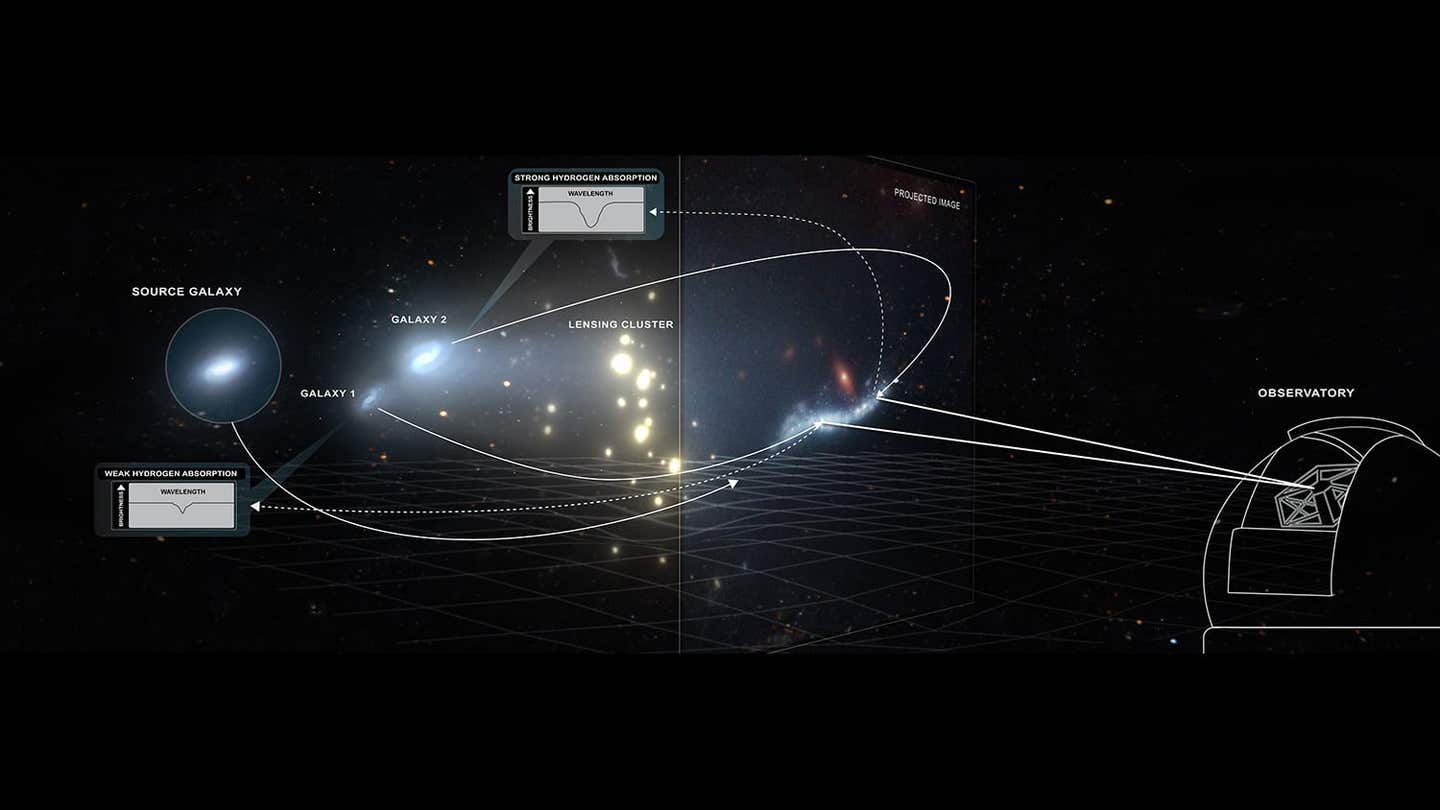Researchers use galaxy as a ‘cosmic telescope’ to study the universe
A unique new instrument, coupled with a powerful telescope and a little help from nature, enables scientists to peer into galactic nurseries

[May 20, 2022: Tracey Peake, North Carolina State University]
An artist’s rendering shows how a cluster of galaxies (lensing cluster) acts as a gravitational lens that magnifies and extends the light from a background galaxy. (CREDIT: W. M. Keck Observatory/Adam Makarenko)
A unique new instrument, coupled with a powerful telescope and a little help from nature, has given researchers the ability to peer into galactic nurseries at the heart of the young universe.
After the big bang some 13.8 billion years ago, the early universe was filled with enormous clouds of neutral diffuse gas, known as Damped Lyman-α systems, or DLAs. These DLAs served as galactic nurseries, as the gasses within slowly condensed to fuel the formation of stars and galaxies. They can still be observed today, but it isn’t easy.
“DLAs are a key to understanding how galaxies form in the universe, but they are typically difficult to observe since the clouds are too diffuse and don’t emit any light themselves,” says Rongmon Bordoloi, assistant professor of physics at North Carolina State University and corresponding author of the research.
Currently, astrophysicists use quasars – supermassive black holes that emit light – as “backlight” to detect the DLA clouds. And while this method does allow researchers to pinpoint DLA locations, the light from the quasars only acts as small skewers through a massive cloud, hampering efforts to measure their total size and mass.
Related Stories
But Bordoloi and John O’Meara, chief scientist at the W.M. Keck Observatory in Kamuela, Hawaii, found a way around the problem by using a gravitationally lensed galaxy and integral field spectroscopy to observe two DLAs – and the host galaxies within – that formed around 11 billion years ago, not long after the big bang.
“Gravitationally lensed galaxies refers to galaxies that appear stretched and brightened,” Bordoloi says. “This is because there is a gravitationally massive structure in front of the galaxy that bends the light coming from it as it travels toward us. So we end up looking at an extended version of the object – it’s like using a cosmic telescope that increases magnification and gives us better visualization.
“The advantage to this is twofold: One, the background object is extended across the sky and bright, so it is easy to take spectrum readings on different parts of the object. Two, because lensing extends the object, you can probe very small scales. For example, if the object is one light year across, we can study small bits in very high fidelity.”
Spectrum readings allow astrophysicists to “see” elements in deep space that are not visible to the naked eye, such as diffuse gaseous DLAs and the potential galaxies within them. Normally, gathering the readings is a long and painstaking process. But the team solved that issue by performing integral field spectroscopy with the Keck Cosmic Web Imager.
Integral field spectroscopy allowed the researchers to obtain a spectrum at every single pixel on the part of the sky it targeted, making spectroscopy of an extended object on the sky very efficient. This innovation combined with the stretched and brightened gravitationally lensed galaxy allowed the team to map out the diffuse DLA gas in the sky at high fidelity. Through this method the researchers were able to determine not only the size of the two DLAs, but also that they both contained host galaxies.
“I’ve waited most of my career for this combination: a telescope and instrument powerful enough, and nature giving us a bit of lucky alignments to study not one but two DLAs in a rich new way,” O’Meara says. “It’s great to see the science come to fruition.”
The DLAs are huge, by the way. With diameters greater than 17.4 kiloparsecs, they’re more than two thirds the size of the Milky Way galaxy today. For comparison, 13 billion years ago, a typical galaxy would have a diameter of less than 5 kiloparsecs. A parsec is 3.26 light years, and a kiloparsec is 1,000 parsecs, so it would take light about 56,723 years to travel across each DLA.
“But to me, the most amazing thing about the DLAs we observed is that they aren’t unique – they seem to have similarities in structure, host galaxies were detected in both, and their masses indicate that they contain enough fuel for the next generation of star formation,” Bordoloi says. “With this new technology at our disposal, we are going to be able to dig deeper into how stars formed in the early universe.”
The work appears in Nature and was supported by the National Aeronautics and Space Administration, the W.M. Keck Foundation and the National Science Foundation. The Australian Research Council Centre of Excellence for All Sky Astrophysics in 3 Dimensions (ASTRO 3D) also contributed to the work.
For more science and technology stories check out our New Discoveries section at The Brighter Side of News.
Note: Materials provided above by North Carolina State University. Content may be edited for style and length.
Like these kind of feel good stories? Get the Brighter Side of News' newsletter.
Tags: #New_Discoveries, #Space, #Astronomy, #Telescopes, #Universe, #Galaxy, #Astrophysics, #Science, #Research, #The_Brighter_Side_of_News
Joseph Shavit
Head Science News Writer | Communicating Innovation & Discovery
Based in Los Angeles, Joseph Shavit is an accomplished science journalist, head science news writer and co-founder at The Brighter Side of News, where he translates cutting-edge discoveries into compelling stories for a broad audience. With a strong background spanning science, business, product management, media leadership, and entrepreneurship, Joseph brings a unique perspective to science communication. His expertise allows him to uncover the intersection of technological advancements and market potential, shedding light on how groundbreaking research evolves into transformative products and industries.



